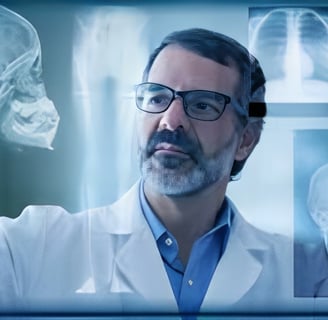AI in X-ray: The Future of Diagnostic Imaging
The world of healthcare is continuously evolving, with technological advancements shaping how medical professionals diagnose and treat diseases. One of the most promising areas of this evolution is the integration of Artificial Intelligence (AI) in diagnostic imaging, particularly in X-ray technology. Traditionally, X-rays have been invaluable tools for doctors, but with the rise of AI, these technologies are now being transformed into even more powerful diagnostic tools. In this blog, we’ll explore how AI is enhancing the future of X-ray imaging, its benefits, challenges, and what lies ahead for this groundbreaking development..
3/26/20254 min read


What is AI in X-ray Technology?
Artificial Intelligence (AI) refers to the ability of a computer or machine to perform tasks that would typically require human intelligence, such as understanding complex data, recognizing patterns, and making decisions. In X-ray technology, AI involves using machine learning (ML) algorithms to analyze images and detect abnormalities in ways that go beyond traditional methods.
AI can examine thousands of X-ray images and learn from them, developing an understanding of what a “normal” image looks like and how to identify when something deviates from the norm, such as fractures, tumors, or signs of disease. This data-driven approach assists radiologists by providing them with more accurate and quicker insights, ultimately improving diagnostic precision.
How AI Enhances X-ray Imaging
1. Improved Accuracy and Early Detection
One of the key benefits of AI in X-ray imaging is its ability to enhance diagnostic accuracy. AI can analyze X-ray images much more quickly and effectively than human radiologists alone. It can also detect patterns that might be missed by the human eye, improving the chances of identifying early signs of disease. This early detection is crucial for conditions like lung cancer, breast cancer, and bone fractures, where early treatment can significantly improve patient outcomes.
2. Reducing Human Error
Radiologists are often required to review hundreds of images in a single day, which can lead to fatigue and the risk of errors. AI-powered systems, on the other hand, don’t experience fatigue, and can provide consistent, accurate analysis for every X-ray image. This helps reduce human error and ensures that no potential issues are overlooked.
3. Faster Diagnosis
Speed is critical in healthcare, particularly in emergency situations where quick decision-making is essential. AI tools can quickly analyze X-ray images and provide immediate feedback to doctors. In emergency rooms or critical care settings, this speed can be the difference between life and death, allowing healthcare professionals to make rapid, informed decisions and provide timely treatment.
4. Enhanced Workflow Efficiency
AI doesn't just help with analysis—it also optimizes workflow within healthcare facilities. AI tools can help prioritize cases, flagging urgent or potentially serious X-ray results so that doctors can address them immediately. By automating some aspects of image analysis, AI frees up radiologists to focus on more complex cases, thus improving the overall efficiency of healthcare operations.
AI’s Role in Specific X-ray Applications
1. Lung Cancer Detection
Lung cancer is one of the deadliest forms of cancer, and early detection is key to improving survival rates. AI has proven to be particularly effective in analyzing chest X-rays for early signs of lung cancer. AI models can identify nodules or other abnormalities in the lungs that might indicate cancer, even before they are visible to human doctors. By assisting radiologists with this early detection, AI can help improve treatment outcomes and reduce mortality rates.
2. Fracture Detection in Orthopedic X-rays
AI is particularly useful in detecting fractures, especially in complex parts of the body such as the spine, wrists, or pelvis. AI-powered systems are trained to identify even subtle fractures in these areas, improving the accuracy of diagnoses. This is especially beneficial in busy healthcare settings, where time is often of the essence.
3. Breast Cancer Detection in Mammograms
AI is also making strides in breast cancer screening, particularly in the interpretation of mammograms. By identifying small, early-stage tumors that might be missed by human eyes, AI can assist in diagnosing breast cancer more accurately. It can also reduce false positives, which can lead to unnecessary biopsies and anxiety for patients.
Challenges of AI in X-ray Imaging
While AI holds immense promise, its integration into medical imaging isn’t without challenges. One of the main obstacles is the need for high-quality data to train AI algorithms. For AI to be effective, it requires access to vast amounts of high-quality X-ray images, and this data must be annotated and labeled accurately by experts. Additionally, there may be concerns around the transparency of AI decision-making, as medical professionals must trust the recommendations of AI systems.
Another challenge is regulatory approval. AI in medical imaging must meet stringent standards and pass regulatory processes to ensure it’s safe and effective for use in healthcare settings. However, as technology continues to evolve and AI systems are proven to be reliable, we can expect more widespread adoption.
The Future of AI in X-ray Technology
As AI continues to develop, its role in X-ray technology is only expected to expand. The integration of AI will likely result in more personalized medicine, as AI tools could analyze a patient’s history, symptoms, and imaging data to create tailored treatment plans. Furthermore, AI systems may be able to predict the progression of diseases based on imaging data, allowing doctors to intervene even before symptoms arise.
In the near future, we might also see the convergence of AI with other technologies, such as 3D imaging, augmented reality (AR), and virtual reality (VR). These technologies could allow healthcare providers to interact with X-ray images in real-time, enhancing their diagnostic abilities and treatment planning.
Moreover, AI-driven tools are likely to become more user-friendly, making it easier for smaller healthcare providers, especially in under-resourced areas, to access advanced diagnostic tools. This could lead to more equitable healthcare outcomes globally.


Reference Website Links:
National Institutes of Health (NIH)
https://www.nih.gov/news-events/news-releases/ai-helps-speed-analysis-medical-imaging
Nature Medicine - AI in Imaging
Harvard Health Blog - AI in Healthcare
https://www.health.harvard.edu/blog/how-artificial-intelligence-will-impact-healthcare-2022011826701
AI in Healthcare
Innovative
Contact Us
Service
xraybazar.com
© 2024. All rights reserved.
Address- Rajasthan, India
Gmail Id- xraybazaroffcial.com
Important Links
